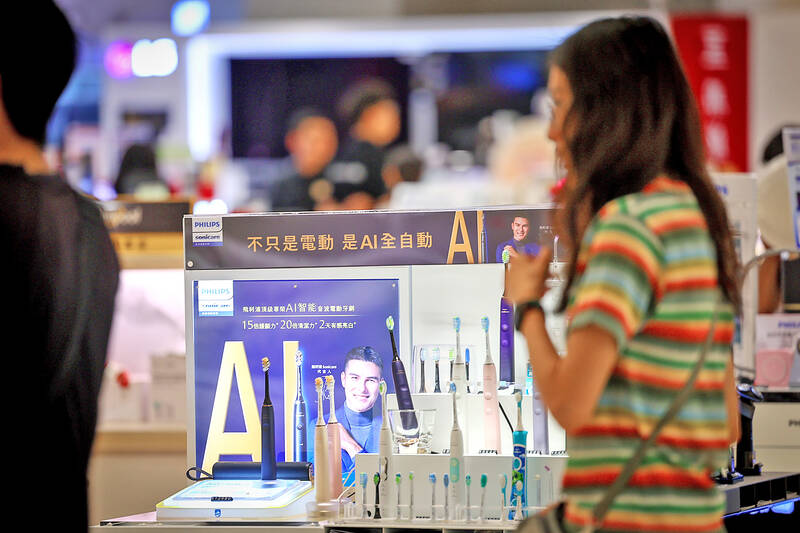The government’s business climate monitor last month flashed “yellow-red” for the second straight month as robust artificial intelligence (AI) demand from abroad continued to bolster industrial output and machinery imports, the National Development Council (NDC) said yesterday.
The monitor’s score stayed unchanged at 35, indicating that the nation’s economy is maintaining momentum, due to rising exports, industrial production and imports of electrical and machinery equipment, it said.
The council uses a five-color spectrum to indicate the nation’s economic health, with “red” suggesting a boom, “green” indicating steady growth and “blue” signifying recession. Dual colors mean the economy is transitioning to a stronger or worse state.

Photo: CNA
“The recovery appears less imbalanced with more sectors coming out of the woods,” council research director Wu Ming-huei (吳明蕙) told a media briefing in Taipei.
Taiwan’s export-oriented economy has benefited from strong demand for AI investment by US technology giants, Wu said.
Firms in the global AI supply chain appeared sturdy, while non-tech firms gradually emerged from inventory adjustments, the official said.
However, manufacturers of chemical, plastic and steel products remained affected by sharp competition from Chinese rivals and Beijing’s termination of favorable tax terms under the Economic Cooperation Framework Agreement, Wu said.
“There is little the Taiwanese government can do on this issue, which carries more political than economic implications,” the official said.
The index of leading indicators, which seeks to project the economic landscape in the next six months, increased 0.87 percent from one month earlier to 103.4, rising for the eighth month in a row, the council said.
All seven component measures displayed upward cyclical movements, consistent with Taiwan’s economic improvement, it added.
The index of coincident indicators, which reflects the current economic situation, increased 1.16 percent to 104.1, rising for the 14th consecutive month, the council said.
Almost all of the seven sub-indices gained points except the reading on the value of exports which weakened slightly from one month earlier.
The council is positive about the economic outlook, as local tech firms maintain leading positions in chipmaking and would show stronger interest in capacity expansion to meet customer needs, the council said.
However, Wu said firms should remain wary about monetary policy by major central banks and volatile geopolitical relationships, as the two factors would affect global trade and therefore, Taiwan’s exports.
In a related development, the consumer confidence index this month was 72.69, rising by an insignificant 0.49 point from last month, indicating a neutral assessment, a survey by National Central University (NCU) showed yesterday.
Of the six components in the index, the confidence reading on stock investment bucked the uptrend and shed 0.97 points to 58.38, as profit-taking pressure built up after the TAIEX rallied to new highs repeatedly, it said.
Dachrahn Wu (吳大任), director of NCU’s Research Center for Taiwan Economic Development, which conducted the survey, said that investors should be cautious, as the US economy, which is the primary end-market for consumer electronic gadgets, might be losing momentum given lackluster consumer spending.

CHIP RACE: Three years of overbroad export controls drove foreign competitors to pursue their own AI chips, and ‘cost US taxpayers billions of dollars,’ Nvidia said China has figured out the US strategy for allowing it to buy Nvidia Corp’s H200s and is rejecting the artificial intelligence (AI) chip in favor of domestically developed semiconductors, White House AI adviser David Sacks said, citing news reports. US President Donald Trump on Monday said that he would allow shipments of Nvidia’s H200 chips to China, part of an administration effort backed by Sacks to challenge Chinese tech champions such as Huawei Technologies Co (華為) by bringing US competition to their home market. On Friday, Sacks signaled that he was uncertain about whether that approach would work. “They’re rejecting our chips,” Sacks

NATIONAL SECURITY: Intel’s testing of ACM tools despite US government control ‘highlights egregious gaps in US technology protection policies,’ a former official said Chipmaker Intel Corp has tested chipmaking tools this year from a toolmaker with deep roots in China and two overseas units that were targeted by US sanctions, according to two sources with direct knowledge of the matter. Intel, which fended off calls for its CEO’s resignation from US President Donald Trump in August over his alleged ties to China, got the tools from ACM Research Inc, a Fremont, California-based producer of chipmaking equipment. Two of ACM’s units, based in Shanghai and South Korea, were among a number of firms barred last year from receiving US technology over claims they have

It is challenging to build infrastructure in much of Europe. Constrained budgets and polarized politics tend to undermine long-term projects, forcing officials to react to emergencies rather than plan for the future. Not in Austria. Today, the country is to officially open its Koralmbahn tunnel, the 5.9 billion euro (US$6.9 billion) centerpiece of a groundbreaking new railway that will eventually run from Poland’s Baltic coast to the Adriatic Sea, transforming travel within Austria and positioning the Alpine nation at the forefront of logistics in Europe. “It is Austria’s biggest socio-economic experiment in over a century,” said Eric Kirschner, an economist at Graz-based Joanneum

OPTION: Uber said it could provide higher pay for batch trips, if incentives for batching is not removed entirely, as the latter would force it to pass on the costs to consumers Uber Technologies Inc yesterday warned that proposed restrictions on batching orders and minimum wages could prompt a NT$20 delivery fee increase in Taiwan, as lower efficiency would drive up costs. Uber CEO Dara Khosrowshahi made the remarks yesterday during his visit to Taiwan. He is on a multileg trip to the region, which includes stops in South Korea and Japan. His visit coincided the release last month of the Ministry of Labor’s draft bill on the delivery sector, which aims to safeguard delivery workers’ rights and improve their welfare. The ministry set the minimum pay for local food delivery drivers at